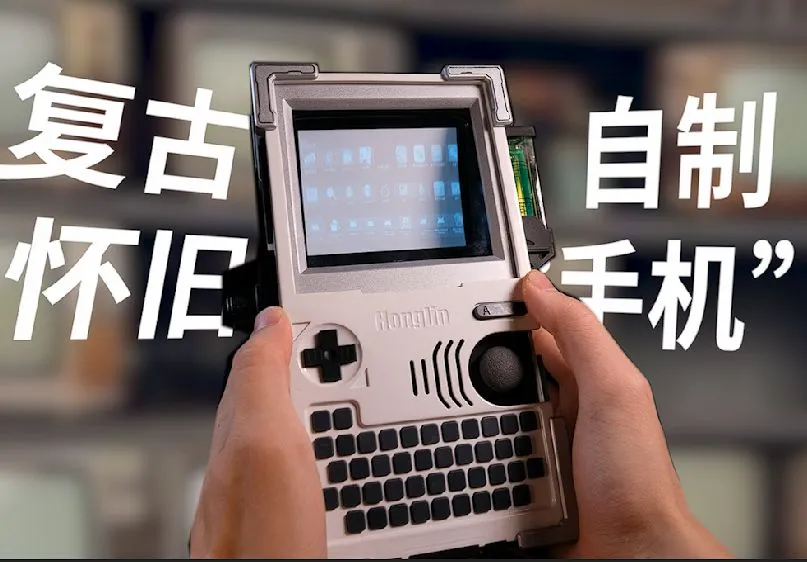 Completed
Completed[Very new but very old] How to build a modern mobile phone with the oldest technology?
PRO [Very new but very old] How to build a modern mobile phone with the oldest technology?
[Very new but very old] How to build a modern mobile phone with the oldest technology?
License
:MIT License
Description
Project Description
Please click me on the video version
What is it like to make a modern mobile phone with contemporary CRT technology? Unlike cold-sensitive LCDs and high-cost OLEDs, the CRT itself is a heat source that glows a warm red light, and the flickering picture reminds me of the happy days when I was a child staring at my grandmother's house shirtless and staring at a big-ass TV.
As a central processing unit, H616 is a cheap and affordable MPU chip that can be purchased for only about 50 yuan. However, in the eyes of developers like me, who don't like to bother, the price is not the most attractive to me, but the rich information and cases are. Because, domestic MPU manufacturers are often cold to developers, and chip information and chip ontology are only provided to companies that have spent money. If you want to find a chip that is easy to buy and supports NTSC output, H616 is the best choice.
This chip also poses a problem, it does not have RF and baseband itself. Unlike a dedicated mobile phone SoC, it is inherently incapable of making calls and surfing the Internet. In order to solve this problem and save money at the same time, I chose to modify a 4G network card that I had done in the previous project. This is the first problem I encountered: there is no driver for Android. Android to play the driver, not like windows just click the mouse to finish, to configure the JAVA environment to install JDK and GCC modification drivers to compile the entire Android. I've been doing MCU development since high school, and I've been doing Linux since my sophomore year, and I'm familiar with changing the program configuration environment, but this 40G source code package and 12 hours of compilation time are really shocking! What a 3A masterpiece is this! I watched as 16GB of RAM was eaten up to a few hundred megabytes. It is not at all the same order of magnitude as the compilation time of a few seconds for a single-chip microcomputer and dozens of minutes for a Linux kernel. But fortunately, after the compilation is successful, the verification can also be used to make calls on the Internet normally.


Generally, I use a star-shaped topography to draw DDR, but this time I used a daisy chain, as shown below:

The DDR3 specification recommends daisy chaining, which is suitable for situations with a large number of pieces, so I made a try here.
Open-source Protocol
MIT protocol, feel free to use.
Project-related Features
It has most of the functions of an Android phone, and can shoot videos, make phone calls, surf the Internet, and entertain. The dessert feature is that it can be entered into the Linux system by changing the memory card (there is no CVBS driver under the Linux system), and it also supports HDMI.
However, without GPS, gyroscopes, and geomagnetometers, navigation is not possible.
Internet access: Air720UH/724 module (Cat.1), the fastest speed is 10M, you can watch 720P videos.
Battery: 2800mAH lithium battery.
Performance: H616+2GB DDR3.
Input: Mouse with keypad + 42 keys keyboard.
Take photos: USB camera.
Project Properties
This project is the first public and is my original project. The project has not won an award in another competition.
Production Process
1. Hardware circuit
Keyboard Firmware Tutorial: https://www.bilibili.com/read/cv10071032/
From bottom to top, there are six-layer board motherboards, picture tube body, and keyboard surface.

The keyboard surface and motherboard need to be combined to form an eight-layer board (6+2). This is designed as a last resort to avoid BGA vias and pad interference of keys. If you can use the blind hole process, you can do it directly with veneer.

Then attach the battery and the 12V boost module.

The combined circuit board and CRT body can be used to create a minimal system.

2. Software system
At this time, you can burn the system image, and the source code address can be seen at the end of the article.
If you need 4G internet/make phone calls. It can be used with Air7xx series modules, reference:https://mozu.wiki/2021/05/15/luatdoc-466.html
It should be noted that the compilation machine needs at least 12G memory, and it is troublesome to modify the source code/device tree.
Here's the image. The download method requires a TF card reader and an 8G card.


After entering the system, you can download the GBA emulator, the old version of WeChat Alipay, BiliBili to start a pleasant Internet surfing!
3. Appearance structure
Combined with the shell (see the attachment for the 3D printing file of the shell)

The installation of each part of the shell mainly depends on glue, and the volume and AB key rely on external modules and flying wires.

I don't know if you are unfamiliar with the atmosphere lamp made by the level on the right, which is made of welding LEDs on the [light board] in the engineering accessories.

The key switch IC is EC190708 .

After welding, it is installed in a 3D printed piece.

The part, in turn, is attached to the large housing. The red wire in the middle is the power cable, one end supplies power to the LEDs, and the other end draws power from the motherboard.

The overall design idea is more modular, less 4G module will only affect the Internet and calling, less camera will only lose taking pictures, less appearance will only affect the visual effect, anyone is welcome to make modifications on my basis.
Future Prospects:

A version of the Rk3588s will be released later, which is more oriented towards PDA, and the picture above shows the motherboard under testing. Swap out the joystick mouse for the same trackball as your BlackBerry. The materials released today have been finalized & received.
Other
Demo video: It will be available by June 30 this year.
Android image (orange pi compatible)https://pan.baidu.com/share/init?surl=hmC4C1YXZpFO68PoEMZfUg pwd:zftr
Any needs/questions can be contacted via private message.
Designed by HongLin (from OSHWHub)
Design Drawing
 The preview image was not generated, please save it again in the editor.
The preview image was not generated, please save it again in the editor. Empty
Empty


Comment